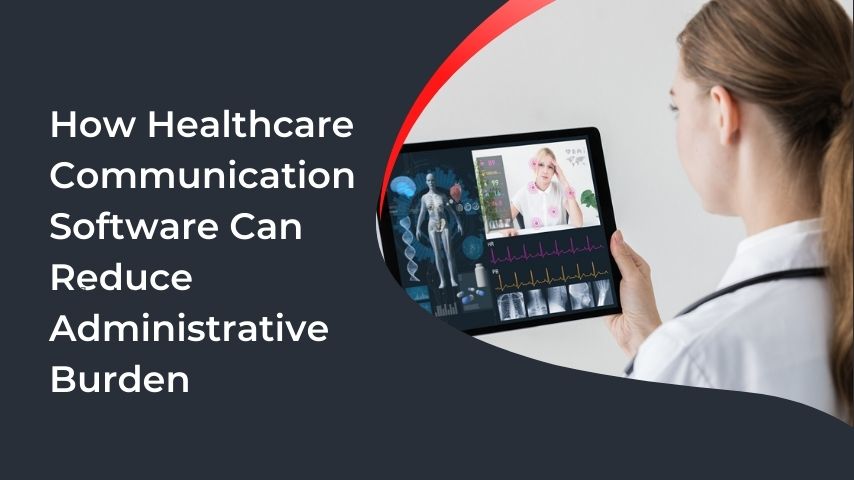Healthcare communication software is revolutionizing the medical industry by streamlining operations and improving the efficiency of healthcare providers. This technology plays a crucial role in reducing the administrative burden that often overwhelms medical staff. By automating routine tasks and facilitating seamless communication, healthcare communication software enables providers to focus more on patient care. In this blog, we will explore how this software can alleviate the administrative load in healthcare settings and the benefits it brings to medical practices.
Understanding the Administrative Burden in Healthcare
Administrative tasks in healthcare can be overwhelming and time-consuming. Medical professionals often spend a significant portion of their day on paperwork, scheduling appointments, managing patient records, and handling billing and insurance claims. These tasks, while essential, can detract from the time and energy that healthcare providers need to devote to patient care. The administrative burden can lead to burnout, decreased job satisfaction, and reduced quality of care.
Healthcare providers are constantly seeking ways to minimize this burden and improve efficiency. Traditional methods of managing administrative tasks are often manual and prone to errors. This is where healthcare communication software comes into play. By leveraging technology, medical practices can automate many of these tasks, streamline workflows, and reduce the overall administrative load.
The Role of Healthcare Communication Software
Healthcare communication software is designed to facilitate efficient communication and coordination within medical practices. It integrates various functions such as appointment scheduling, patient records management, billing, and secure messaging into a single platform. This integration allows healthcare providers to manage all aspects of their practice more effectively, reducing the need for manual processes and minimizing the risk of errors.
Addition – Ready to reduce your administrative burden and enhance patient care? BlueSecure.ai offers top-of-the-line Healthcare communication software designed to streamline your operations. Whether you’re looking to improve patient records management, automate billing, or enhance team communication, BlueSecure.ai has the solution for you.
One of the key features of healthcare communication software is its ability to automate routine tasks. For example, appointment scheduling can be automated, allowing patients to book, reschedule, or cancel appointments online. This not only saves time for administrative staff but also improves patient satisfaction by providing a convenient and user-friendly scheduling system. Similarly, automated reminders can be sent to patients via email or SMS, reducing the number of missed appointments and ensuring better adherence to treatment plans.
Improving Patient Records Management
Managing patient records is a critical aspect of healthcare administration. Traditionally, patient records were maintained in paper form, which was cumbersome, time-consuming, and prone to errors. With the advent of electronic health records (EHR) and healthcare communication software, patient records management has become more efficient and accurate. Healthcare communication software allows medical practices to maintain digital records that are easily accessible, secure, and up-to-date.
Digital records can be accessed by authorized personnel from anywhere, at any time, facilitating better coordination and communication among healthcare providers. This is particularly beneficial in emergency situations where quick access to patient information is crucial. Additionally, electronic records reduce the risk of lost or misplaced documents, ensuring that patient information is always available when needed.
Streamlining Billing and Insurance Claims

Billing and insurance claims are another major source of administrative burden in healthcare. The process of submitting claims, tracking payments, and managing denials can be complex and time-consuming. Healthcare communication software simplifies this process by automating billing and claims management. It integrates with billing systems and insurance providers, allowing for seamless submission and tracking of claims.
Automated billing reduces the risk of errors and ensures that claims are submitted promptly. This leads to faster reimbursement and improved cash flow for medical practices. Additionally, healthcare communication software can provide detailed reports and analytics, allowing practices to identify and address any issues that may be causing delays or denials in the claims process.
Enhancing Communication and Collaboration
Effective communication is essential for the smooth operation of any healthcare practice. Healthcare communication software provides a secure platform for communication between healthcare providers, administrative staff, and patients. Secure messaging features allow for the exchange of sensitive information while ensuring patient privacy and compliance with regulations such as HIPAA.
Improved communication and collaboration among healthcare providers lead to better coordination of care and improved patient outcomes. For example, physicians can easily share patient information and treatment plans with specialists, ensuring that all members of the healthcare team are on the same page. This reduces the risk of errors and ensures that patients receive comprehensive and coordinated care.
Reducing Staff Burnout and Improving Job Satisfaction
The administrative burden in healthcare can lead to staff burnout, which is a significant issue in the industry. Burnout not only affects the well-being of healthcare providers but also impacts the quality of care they provide. By reducing the administrative load, healthcare communication software can help alleviate burnout and improve job satisfaction.
Automating routine tasks frees up time for healthcare providers to focus on patient care and other critical aspects of their practice. This leads to a more fulfilling work experience and reduces the stress associated with administrative tasks. Additionally, improved efficiency and streamlined workflows create a more organized and productive work environment, contributing to higher job satisfaction and better retention of staff.
Conclusion
Healthcare communication software is a powerful tool that can significantly reduce the administrative burden in medical practices. By automating routine tasks, improving patient records management, streamlining billing and insurance claims, enhancing communication and collaboration, and reducing staff burnout, this technology transforms the way healthcare providers operate. The result is a more efficient, productive, and patient-centered healthcare environment.
Implementing healthcare communication software is an investment in the future of your practice. It not only improves operational efficiency but also enhances the quality of care you provide to your patients. As the healthcare industry continues to evolve, embracing technology and leveraging healthcare communication software will be essential for staying competitive and delivering the best possible care.
For more insightful articles related to this topic, feel free to visit technewsideas.com


